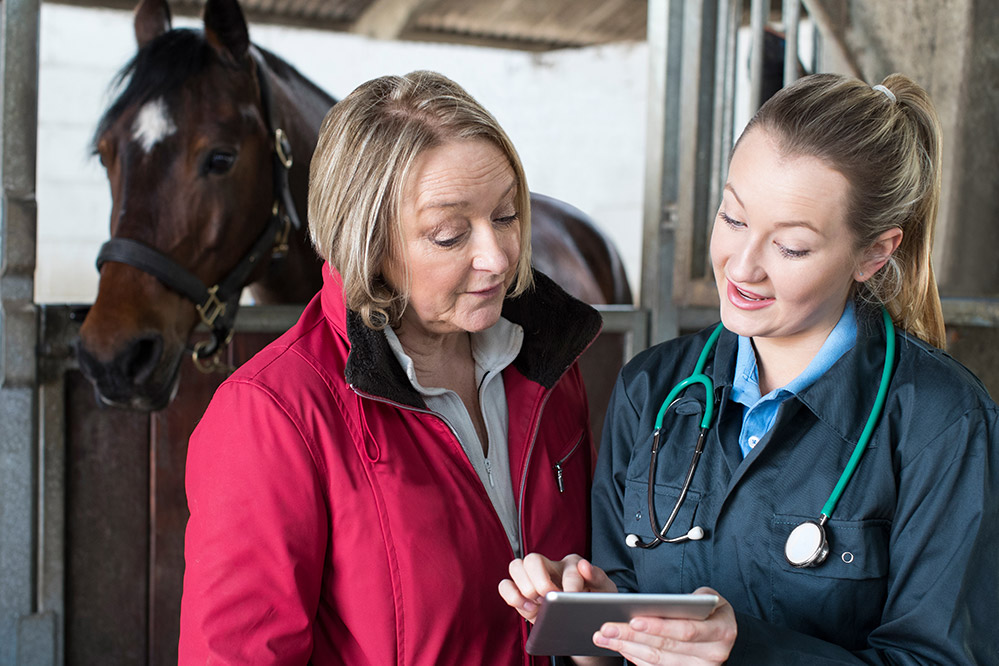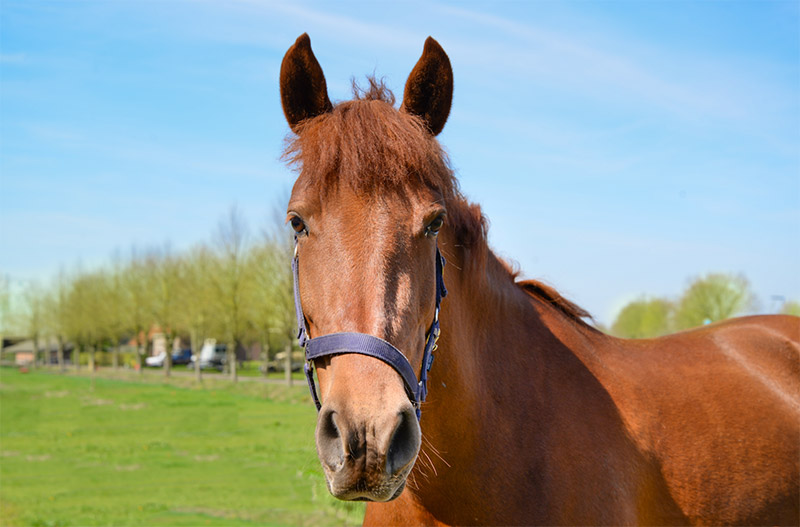Section 3 | Biosecurity and Health Management on Ontario Equine Premises
Industry
Page 14 /
Infection Prevention and Control
Decreasing Exposure to Pathogens
The hallmark of biosecurity is reducing risk, and to do this, it’s important to consider areas where we can reduce exposure to disease.
Decreased exposure to pathogens can be achieved by managing:
- Animal movement and flow
- Cleaning and disinfection
- Traffic and access
- Pests and parasites
Check out this overview of how pathogens are spread, developed by Equine Guelph:
Animal Movement and Flow
Prevent the spread of disease and reduce animal exposure by monitoring and controlling animal movement. Below are some important considerations to prevent diseases from entering, spreading within, and leaving a facility.
Newly Arrived or Returning Animals
Separating newly arrived and returning animals can minimize the spread of diseases they may have after being exposed to disease at another location.
You should consider three key practices:
- Obtain vaccination, deworming and other pertinent health information for newly purchased animals, or animals that will be staying at your facility
- Have designated equipment for these animals that is separate from other equipment
- Work with your veterinarian to determine an SOP for quarantining new and returning animals
How Long Should I Quarantine Horses?
According to the National Standard, a 5-7 day quarantine period may be appropriate for animals known to be in good health, and that have not been exposed to any other animals.
A 14 day quarantine is suggested for animals coming from facilities with similar management conditions to your own (i.e. similar vaccine and deworming protocols).
A 3-4 week quarantine period should be considered for animals of unknown health status and health should be evaluated daily. This could include identification and recording of diarrhea, coughing, appetite, and temperature. Animals in quarantine may also be vaccinated and dewormed if they are determined to be healthy.
You may consider integrating newly arrived animals if they:
- Test negative for key diseases
- Have a thorough medical history
- Have been examined by a veterinarian and deemed to be in good health
Equine Guelph has developed a checklist to prevent pathogens being brought back to your facility when you travel with your horse: Don’t Bring Anything Home With You! Travelling Horse Checklist
Visiting Animals
Animals arriving at a facility for a short period of time (i.e. a show or event) should have known disease status prior to entry. These animals carry the same risks as newly arriving or returning animals.
Some important considerations include:
- Using stall mucking equipment designated for visiting animals and disinfected between animals
- Having a separate stall or paddock for their use
- Keeping animals separate from resident animals that do not leave the premises
- Keeping animals separate from animals that are more susceptible to disease (e.g. two-year-old animals in training, yearlings, breeding mares)
High Risk Animals
Animals that are likely to be a source of infection should be quarantined. This includes animals that are showing signs of disease, have been exposed to animals that are known to have disease, as well as those that are recovering from disease. It is possible that these animals are still able to spread disease while they are not showing symptoms.
Reduce the number of animals these horses may be in contact with by housing separately and/or using separate paddocks.
These animals should be fed, cleaned, and handled last, so as not to spread pathogens from clothing, hands, or equipment to other herdmates.
Equine Guelph has developed a checklist for isolating animals that can be found here:
Isolate Sick, New & Travelling Horses
Susceptible Animals
Depending on their age and immune status, certain groups of animals are not as well equipped to defend themselves against invading pathogens. Foals, pregnant, and older animals have less capacity to fight off invading pathogens and so their exposure to animals that may be spreading pathogens should be kept at a minimum.
These animals should be fed, cleaned, and handled first, to reduce their exposure to pathogens that may be picked up from other animals and spread on clothing, hands, or equipment.
Keys to remember:
- Be aware of the health status of animals entering the facility
- Animals should not leave your premises if they are showing signs of disease. This will prevent the spread of pathogens to other facilities!
- Take extra care with high risk and susceptible animals
- Work with your veterinarian to develop animal movement protocols to determine which animals should be allowed to enter, and when/if an animal is fit to commingle with other animals for an event, race, show, or at a training or breeding facility
Cleaning and Disinfection (Clean, Rinse, Disinfect, Repeat)
Equipment: Trailers, stalls, alleyways, feeding equipment, grooming equipment, medical supplies, pitch forks, wheelbarrows, etc. should be thoroughly cleaned and disinfected after each use, and particularly between animals. Use designated equipment for animals in isolation to avoid spreading infectious pathogens to other animals within the barn.
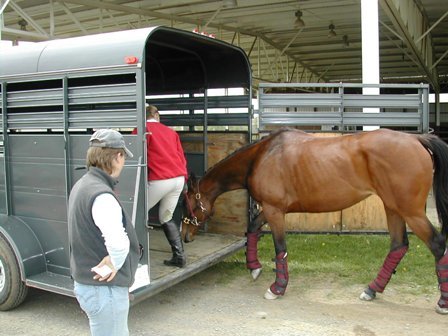
Source: NAPA
Clothing: All staff and visitors should be wearing clean clothing and footwear, and should be encouraged to wash their hands or use sanitizer after handling an animal. Consider wearing disposable gloves, and wear coveralls as a removable barrier to pathogens. These items can easily be changed or removed to prevent the spread of infection.
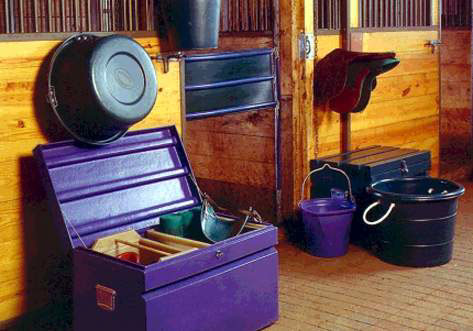
Source: Dan’s Saddlery
Traffic and Access Control
Monitor and manage individuals who are allowed access to your facility, and be sure that those allowed entry are familiar and compliant with the biosecurity protocols you have in place. This will reduce the opportunity for pathogens to be spread to resident animals from other facilities or animals.
Establish biosecure zones where only certain personnel are allowed access:
- Controlled access zones are the land and buildings where animals are kept. Establishing and maintaining a controlled access zone dictates who is allowed to come onto the property, and where they are allowed to access
- Restricted access zones are areas within the controlled access zone where entry is further restricted. This is typically where animals are housed and cared for. This may be restricted even further to isolate new, returning, or sick animals
Check out Equine Guelph’s infosheet entitled:
Facility Design with Biosecurity in Mind
Control traffic by having designated laneways, gates, and signs to give visitors an idea where they are allowed to go, and how to contact you to access your premises. Keep these areas clean to prevent pathogens from being spread as vehicles and humans move throughout the facility.
Work with your veterinarian to identify areas on the premises that might benefit from having restricted access. Ensure all staff and visiting personnel are familiar with different access zones and biosecurity protocols in place.
Equine Guelph has developed a best management practices infosheet that can be found here:
Equine Biosecurity and Access Management
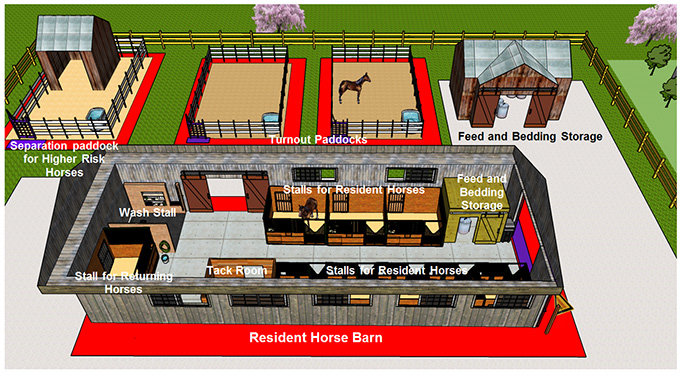
Source: CFIA
Pest and Parasite Management
Feed Storage: Reduce the appeal of the barn to insects and rodents by ensuring that feed is stored in a locking bin in good condition, any spilled feed is cleaned up, and that storage areas are kept clean to reduce nesting areas for rodents.
Standing Water: Prevent mosquito breeding by reducing or removing standing water in pastures and paddocks.
Routine Screening: Briefly checking the legs of animals coming in from pasture for ticks can minimize the time they spend attached and feeding.
Barriers and Cleanliness: Use screens in windows to prevent flies from entering, and prevent the accumulation of manure to reduce breeding.
Pasture Management: Ensure pastures are kept free of excessive manure build up by maintaining an appropriate stocking density, and use a routine deworming protocol developed by your veterinarian to reduce the spread of intestinal parasites. Only thoroughly composted manure should be spread to pastures and paddocks to prevent the spread of parasites and bacteria.
